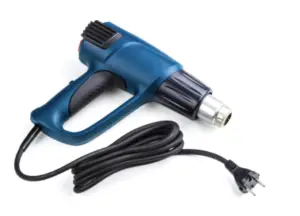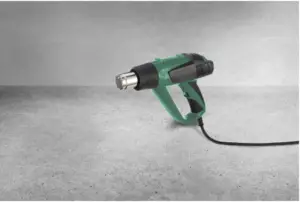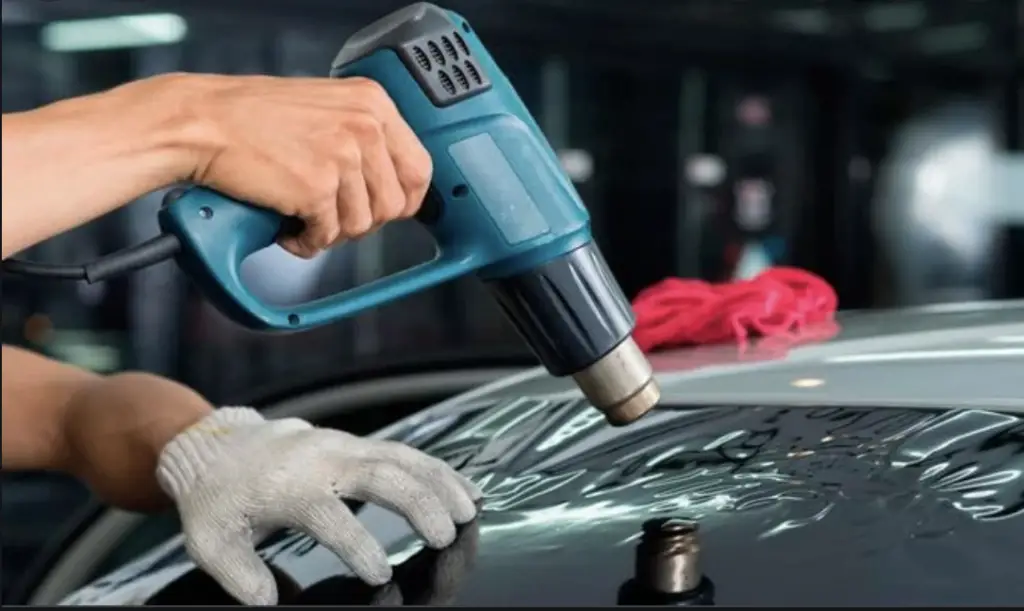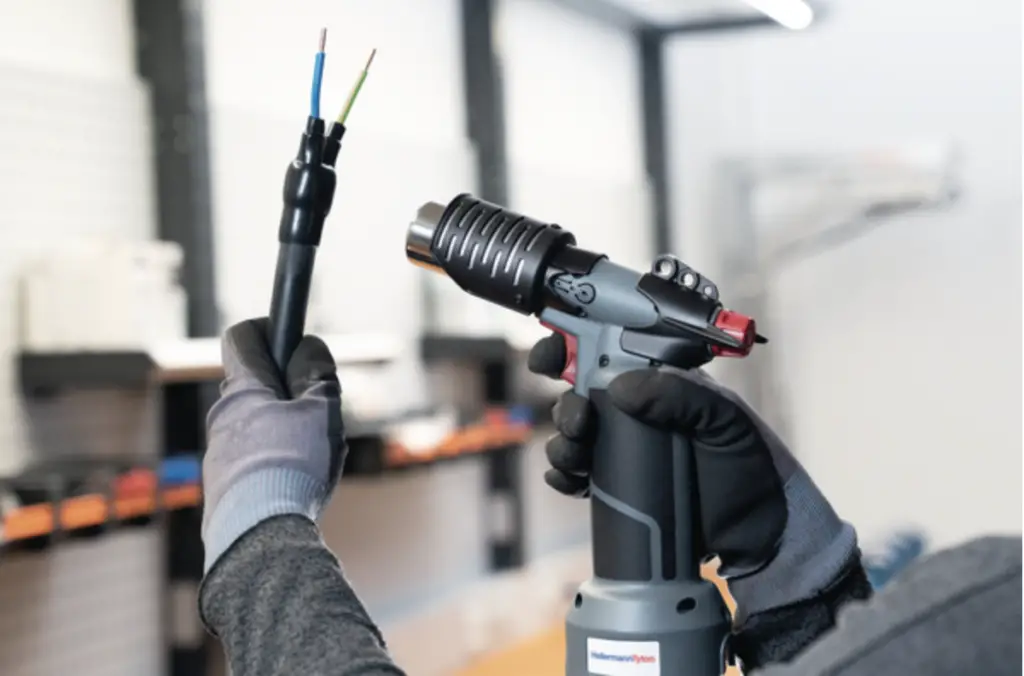Choosing the best heat gun for home or hobby can save you lots of time and effort
Whether for removing stickers, repairing cables, or even lighting the barbecue in the garden, the best heat gun is always a good choice if you want to repair, weld or solder effectively with the help of high temperatures.
Take a look at our guide on how to choose the best heat gun and find out which heat gun is best for your needs.

What is a heat gun?
The function of a hot air blower is based on sucking in air from the environment, which is heated inside the device and expelled from the nozzle at the desired temperature.
A heat gun can reach a temperature of up to 650 degrees and is often used to remove layers of paint or to heat charcoal.
Good heat guns (also available as a mini version for hobbyists and model builders) are usually available for less than $20. When buying, it is important to find out beforehand which temperatures you need to carry out the work. For example, not every heat gun reaches 600 degrees.
Best heat gun comparison
The varnish from the furniture has to be removed, the charcoal needs to be heated or you want to glue materials together: Heat is the easiest way to do this work. The ideal device for this is a heat gun, which should not be missing in any craftsman’s workshop.
Our heat gun comparison 2021 shows that the range is huge. Which is the best heat gun and which criteria should you pay particular attention to in a heat gun test?
In this buying guide, we will show you how to find the best heat gun for you, how the heat gun works, and give you practical tips.
How does a heat gun work?
A heat gun does nothing but suck in the air from the environment, heat it with a heating element, and let it exit again at the nozzle. This reaches a temperature between 50 and 650 degrees (depending on the model and setting). The function is therefore identical to that of a hairdryer.
In order to be able to carry out the work with the blower working with hot air in a targeted manner, hot air guns can be equipped with various nozzle attachments. There are extra wide nozzles, point nozzles, edge protection nozzles, grill lighter nozzles or deflection, and paint scraper nozzles.

Different types of heat guns
Each heat gun consists of a motor that draws in the ambient air and a heating element that heats the air flowing past. A major difference is the type of drive: In the heat gun test, you will find wired and battery-powered models. There are also gas-powered heat guns, but these are hardly available on the market.
Heat gun with cable: the powerful classic
The majority of the heat guns in the test have a cable and are therefore dependent on the mains current. Power is supplied via a standard 230-volt socket. Since the models are continuously supplied with power, you can work with them for a longer period of time. Thanks to the lack of a rechargeable battery, hot air guns with cables are usually light and easy to hold.
Benefits
- Lightweight
- Easy handling even when working for a long time
- Running time is ensured at all times by a constant power supply
- Usually higher performance
- Allows comparatively high temperatures
Disadvantages
- An extension cable may be required depending on the place of work
- Inflexible as it depends on the socket
- The danger of tripping due to cables
- The power cord can get in the way / get tangled during work
- The cable can get into the hot airflow
Cordless heat gun: The flexible alternative
Many manufacturers now offer cordless heat guns that are operated with a battery. Since they do not depend on the mains power supply, you can use the models anytime and anywhere – whether in the garage, in the garden shed, or outdoors.
If you have a replacement battery, this variant is also suitable for continuous use. However, cheap models are often very heavy, unwieldy, have less power, and thus reach less high temperatures.
Benefits:
- No power connection is necessary
- No annoying cable
- Very flexible to use – for example outdoors
- No risk of tripping while working
- High-quality models provide sufficient performance
Disadvantages
- Often very difficult due to the integrated battery
- Heavy and unwieldy models are not suitable for beginners
- Limited battery life
- Often times do not reach the same temperatures as models with a cable
- Depending on the state of charge
- Continuous use is only possible with an exchangeable battery
Choosing a battery-powered heat gun
Heat guns with batteries or cables have their special features. Here it is important to consider whether heat guns with rechargeable batteries would be easier for you in practice, as your areas of application may not allow a good power connection. Especially when working outdoors, it can be uncomfortable if an extra extension cable has to be laid every time for short use.
Are you inclined to buy a battery-powered heat gun? Take a closer look at the advantages and disadvantages of these models:
- Locally independent and therefore practical to be able to help quickly with construction sites or the neighbors.
- No source of danger due to cables lying on the floor.
- Unrestricted freedom of movement.
- Because of the battery, it is heavier in weight, therefore not always so easy to use for precise work.
- Short battery life may not always be sufficient for heavy use purposes.
What do you have to pay attention to in the heat gun?
The temperature determines the possible uses of a heat gun
In a heat gun test, it quickly becomes clear that there are very big differences in how the heat gun can be controlled.
Basically, all heat guns are equipped with temperature control, but there are models with only 2 power levels (for example the Bosch PHG 500 2 Easy) up to the professional heat gun with 60 power levels (for example the Skil 8004 AA). The more precise and varied your work, the more precisely you should be able to regulate the heat gun. A temperature of around 450 degrees is required to remove paint.
Tip: It is worthwhile in a heat gun test to compare the models in terms of their temperature ranges and spend more money if you then have no restrictions in your work.

Different nozzles of a heat gun can save costs
If you buy a heat gun with a set, you will usually find extensive accessories in it. If different nozzles are already included in the set, a separate purchase is not necessary, so that money can often be saved.
If you cannot decide between two models, then the set with the larger range of accessories is always a good choice.

The overheating protection is good for heat gun safety
In fact, not every heat gun is equipped with overheating protection. But depending on the watt, performance and work, you tend to forget the heat such a device can develop. If you work constantly over a longer period of time at 550 degrees, you should think about switching off and cooling down from time to time.
So that the devices do not get too hot, some are equipped with additional overheating protection, which automatically switches the device off and only enables it to be switched on again when the temperature is no longer too high.
A heat gun with integrated overheating protection is, for example, the Einhell TH HA 20001. If you buy this heat gun, you also enjoy the advantage that the device can be set up. This often makes precise work even easier!
A mini heat gun is usually sufficient for hobbyists
If you want to buy a heat gun so that you can do handicrafts or model building, an inexpensive mini heat gun is often sufficient.
Mini heat gun stick creates temperatures of up to 400 degrees and is also very cheap with a price of less than $50. The handling of the small device is also quite pleasant – especially over many hours.
The dirt filter guarantees a long service life for your heat gun
If you buy a good heat gun, it should come with a dust and debris filter. This prevents sucked-in particles from clogging the device over the long term.
Since a dirt filter can be replaced, you extend the service life of the device. Not every heat gun is equipped with a dirt filter, so pay particular attention to this point.
How do I recognize the best heat gun?
Whether a cordless heat gun or a corded model – a good device is not only powerful, it also reaches temperatures of up to 650°C, covers the largest possible temperature range, and is supplied with practical accessories. The following buying guide will tell you which purchase criteria are also decisive, what the heat gun test results and how much a good heat gun can cost.
Heat guns belong to the group of hot air blowers and are used to heat a specific material or work area. The soldering station or the Bunsen burner take on very similar tasks. But the following criteria make the difference:
Power consumption: It doesn’t just depend on the wattage
The power consumption in watts (W) shows you how powerful the heat gun is. For many battery-operated devices, it is given as voltage in volts (V). Most heat guns in the test, especially corded devices, have an output between 1,750 to 2,200 W. Mini heat guns also work efficiently with 500 W. However, they are only suitable for small handicrafts, for example in model making. Some professional devices have a power consumption of up to 3,400 W. However, 2,000 W is sufficient for DIY use.
What’s more important is the temperature settings of the best heat guns.
Best heating gun temperature levels: the more precise, the better
Almost more important than the wattage is the minimum and maximum temperature. While you should work with low temperatures when soft-soldering PVC, you need significantly higher temperatures of around 450 ° C to remove the lacquer. For soft soldering iron even 550°C is necessary.
High-quality heat guns reach up to 650°C. Battery-powered models, on the other hand, rarely manage to exceed 450°C.
Most devices have several temperature levels, at least 2 or 3. Professional models offer up to 60 temperature levels, which usually cover a temperature range of 50 to 650°C. With continuously variable heat guns, you can set the exact temperature and read it off on the LCD display.
Heat gun airflow: A lot or a little hot air?
The maximum airflow tells you how much air the engine can suck in and heat up. If you are working in large areas, you should select the highest possible amount of airflow. Most devices have an airflow of around 500 to 550 liters per minute (l / min).
For particularly fine, punctual work, you should reduce the airflow a little.

Best heat gun accessories: nozzles, batteries, and such
Most devices come with a large scope of accessories. Heat guns are equipped with several nozzles, scrapers, spatulas, or suitable storage cases. The most important accessories are the nozzles that are attached to the heat gun.
Before buying, consider which nozzles you need and whether they are already included :
- Reducing nozzle: Concentrate the airflow on a specific area
- Wide jet nozzle: useful for removing old layers of paint and varnish
- Reflector nozzle: suitable for soldering pipes and for working with shrink tubing
- Blasting nozzle / glass protection nozzle: Redirect the hot air and thus protect the surface
- Edge protection nozzle: suitable for removing window paint, for example
- Grill lighter nozzle: For lighting barbecue coals
Please note that the battery and the appropriate charger are included in the delivery of cordless heat guns. If you buy them separately, they are usually more expensive than in a set.
Safety tip when working with heat guns
Removing paint residue with a heat gun is very easy, but the toxic gases also pose a health risk. Therefore, please do not forego the use of a respirator. Good ventilation must also be ensured in the interior.
How much the best heat gun should cost?
If you want to buy a heat gun, you don’t have to spend a lot of money on it. Good models such as those from Mannesmann are available for less than $20. Of course, cheap heat guns often cannot keep up with the same quality and service life of a high-quality device.
Higher price often convinces with more performance and higher quality workmanship.
For a Makita heat gun like the HG650CKIT, on the other hand, you pay more than $100 but receive a practical transport case, several nozzles, and a pressure roller. With a weight of fewer than 700 grams, the Makita heat gun is also one of the particular light models, which makes working much more pleasant.
Tip: Do not always choose the cheapest model or a device without certification. Inferiorly processed devices can lead to severe burns.
FAQ
Can I use a hairdryer instead of a heat gun?
A heat gun can be used to carry out a lot of work that is much easier due to the heat. With a hot air gun, the temperature is adjustable. Accordingly, the hairdryer can be adapted to light work.
If you want to bend polypropylene (PP), you need less than 300 degrees for this, but for iron, it should be over 500 degrees and if you want to light your charcoal grill with a hot air blower, you need one thing above all in addition to a lower temperature: flexibility.
Many heat guns in the test convince with their performance, but if the barbecue in the garden can only be reached with an extension cable, this is definitely impractical, the experts say. For this reason, there are heat guns with a battery instead of a cable.

